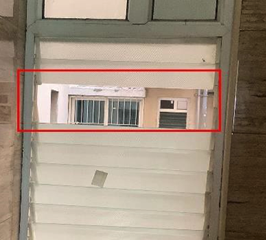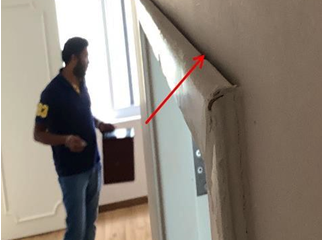An analysis of cracks by one of our Home Inspectors – Mohammed Hanifa. A 10 minute read.
What are cracks?
Narrow gaps/lines on the surface of the concrete that splits apart are called cracks. Technically the voids present in the paste-aggregate interface the neighboring voids which persist in forming a minor crack. Concrete provides structures with strength, rigidity, and resilience from deformation. These characteristics, however, result in concrete structures lacking the flexibility to move in response to environmental or volume changes. Cracking is usually the first sign of distress in concrete. It is, however, possible for deterioration to exist before cracks appear. Cracking can occur in both hardened and fresh, or plastic, concrete as a result of volume changes and repeated loading. This involves tensile stresses being loaded onto the concrete, the cracks occurring when the force exceeds its maximum tensile strength.
Why do cracks occur in concrete?
Cracks are formed by the stress and strain in the concrete due to thermal movements, moisture changes, chemical action or by the externally applied forces like dead leaves, wind or seismic zone or foundation settlement. Let us look at a few reasons:
- The primary reason for cracks is excess water in the concrete mix. Deliberately excess water is added at the job site to make concrete easier to install however, it reduces the strength and causes shrinkage cracks.
- Rapid drying is another reason for cracks, the chemical reaction takes place when concrete dries that allows to transform liquid to solid state. This is due to hydration which persists for a week after concrete is poured. It is commonplace to cure the concrete so that the adequate water is available for hydration.
- Lack of strength in the concrete is another reason for concrete cracks where the honeycombs, voids in the concrete persist to coalesce thus forming cracks.
- The alkalis react with the silica in the concrete from which the cement is made, this makes the concrete to carbonate slowly inside from the external concrete and eventually making the concrete spilt (crack, spall, etc).
Classification of cracks
Cracks could typically be classified as structural or non-structural.
Structural cracks are due to erroneous design, unsound construction / overloading which may lead to disaster.
Non-structural cracks are mostly due to internally induced stresses in building materials & these generally do not directly result in structural weakening. Sometimes, non-structural cracks may be due to penetration of moisture through cracks or weathering action, resulting in reinforcement corrosion and thus may render the structure unsafe. Non-structural cracks, normally do not endanger the safety of a building, but may look unpleasant or may create an impression of faulty work or may give a feel of the dubiousness of concrete strength, spoil the internal finish (due to moisture penetration), thus adding to cost of maintenance. It is, therefore necessary to adopt measures for prevention or minimization of these cracks.
Types of cracks :
- Plastic/shrinkage cracks.
- Separation cracks.
- Settlement cracks.
- Hairline cracks.
- Corrosion cracks.
- Horizontal cracks.
- Diagonal cracks.
Plastic/shrinkage cracks: This is because of the excess water evaporating from the concrete. The wetter the concrete mix, the more the concrete will shrink. Slabs of concrete can shrink up to ½ inch per 100 feet. The force from the shrinkage causes the concrete slab to be pulled apart, which is where the cracks come from. To prevent cracking from too much water, make sure you know the allowable amount of water for the mix.

Separation cracks: The crack occurs after few months of the construction only due to the differential strain in the junction of the Reinforcement concrete (RCC) member and masonry wall because of elastic deformation, shrinkage and creeps in RCC member acts upon.

Settlement cracks: The crack formed on the RCC foundation due to the settling of soil/ increase in soil water table that soil erosion/ design failure.

Hairline cracks: Hairline cracks are the cracks which are exposed on the surface of the concrete is barely small and perceptible. The crack less than .003 mm – .08 inch in width is called hairline crack. The hairline crack can be shallow and quite deep. However, it varies on the severity of the depth of the crack.

Corrosion cracks: These cracks due to corrosion steel/rebar in the concrete, which persist in spalling of concrete.

Horizontal cracks: Crack which are formed for reasons like RCC member undergoes alternate expansion and contraction due to change in ambient temperature, inadequate cover concrete in RCC member and Horizontal cracks in the topmost storey of the building at corner cause upliftment of the slab corners due to deflection of the slab in both directions.


Diagonal cracks: Diagonal crack accompanied by outward tilting in the external walls. Poor mortar joints are one of the reasons for diagonal cracks.Also, the cracks occur due to moisture movements and shrinkable soil, especially black cotton soil when the foundation is shallow.


Consequences of cracks:
The consequences of above-mentioned cracks depend on their severity. However, these are heterogeneous but eventually, it reduces the strength, duration/lifespan of the structure. The general consequences of cracks like hairline, horizontal, and shrinkage cracks – Allows dampness in the internal walls from external crack, due to which the concrete is carbonated/deteriorated and corroded steel/rebar by moisture contiguity. separation/diagonal cracks result in masonry wall collapsing, hence it is not bonded well to the member. Settlement cracks result in structural failure chances of the structure collapse.
How to repair cracks?
The cracks in the concrete are the common occurrence in the structure and engineer are often required to look into their causes and suitable repair and remedial measures. Repair to be effective the engineer needs to understand the root cause of the cracks with the regular investigation (ie; characteristics/behaviour of the cracks and collect information about specification of the job, time of construction and past history of the structure). Plastic/shrinkage cracks – Cracked RCC member to be cleaned thoroughly with using water (under pressure) / sandblasting to perceptible all shrinkage cracks. Cracks to be ‘V’ grooved and filled with the suitable filling material.
- Separation/Horizontal/Diagonal – The cracks between to be ‘V’ grooved the gap between to be injected with the suitable filling material at low viscosity and later the joint the to be replastered with using chicken mesh.
- Hairline cracks – The cracks between to be ‘V’ grooved the gap between to be injected with the suitable filling material at low viscosity.
- Corrosion cracks – The exposed steel/rebars to be cleaned thoroughly and anti-corrosive chemical to be applied on the rebar later it should be plaster after applying bonding chemical.
- Settlement cracks – It depends on the which types of settlement, whether it is a design failure or soil erosion. It should be analyzed and recommended based on it.


